Now, when in many regions of Russia one or another popular Internet service can be turned off at any time, VPN is gaining particular popularity. However, not all users know what it is and how to encrypt their connection on an iPhone or iPad. But sometimes it is simply necessary.
First, let's figure out what is meant by VPN. This is a technology for protecting your Internet connection, which works on a fairly simple principle: your device makes a request to connect to a VPN server, and only then you get online, due to which all traffic goes through the VPN. Roughly speaking, this is a kind of intermediary between you and World Wide Web, which in addition provides an IP address, masking the real location of the user.
There are quite a few ways to install a VPN on an iPhone or iPad, but today we will look at one of the simplest and most common - installing a special application from a VPN service.
One of these programs may already be familiar to some of our readers - TunnelBear. Install it for free on your iOS device using the link below, register and receive 500 MB per month for your travels on the Internet. For publishing on Twitter, the service will give you a bonus one gigabyte.
After downloading the application, you will be asked to install a TunnelBear profile, and after that you can use the utility to your heart's content. Simply select the country whose server you want to use and connect to it. For an additional fee, you can expand the number of gigabytes available for surfing the Internet.


Name:
Publisher/Developer:
Price: For free
In-App Purchases: Yes
Compatibility: Universal application
Link: Install
Other useful program for VPN on iOS - Cloak. The installation procedure is exactly the same: download the application (free) from, install the profile and add a new VPN configuration. There is a free trial period of 30 days, but if you wish, you can choose one of tariff plans no gigabyte limits.


You will know that VPN is enabled on your iPhone or iPad by the corresponding icon on the top panel.


Name: Cloak - Super Simple VPN
Publisher/Developer: Bourgeois Bits LLC
Price: For free
In-App Purchases: Yes
Compatibility: Universal application
Link: Install
If you are often on public Wi-Fi networks, using a VPN becomes a real necessity. Therefore, these utilities will be useful to any user of iOS gadgets who spends significant time on the Internet.

On the Internet, you may encounter a situation where you cannot get to the site you need due to the fact that you have limited territorial access to it. That is. the site is not available to Russian citizens, for example. But in such a situation there is a solution, and setting up a VPN will help here.
Virtual Private Network is translated as a virtual private network. This setting allows you to encrypt your Internet connection, and you will be able to use any opportunity to access the network without fear of virus attacks. At the same time, you will always be anonymous on the sites you visit.
Initially, such a connection was used by companies to enable staff to access systems remotely. For example, while on a business trip or from home. Now such connections are used by individuals to receive safe internet connections at public network access points. Or to be able to use the Internet in countries with limited access.
Why do you need a VPN on iPhone 6?
The principle of VPN operation is quite simple. Your phone generates a request to connect to the VPN service. After that he gets caught in the net. While all traffic goes through the VPN. If you imagine figuratively, this is an imaginary link between your device and the entire Internet, which allows you to get an IP address. This address masks your actual location.
How to set up VPN on iPhone 6?
There are several ways to enable VPN on your iPhone. The simplest and most popular is installation through the special TunnelBear application. You can install it for free from the Internet. When the application download is complete, you will automatically be prompted to install the utility profile. Next, you need to select the country from the list provided, the server you are going to use and connect.
If this option does not suit you, you can download free application V App Store for IOS - Cloak. The operating principle is the same here. You download, install and set parameters. Enabled VPN will be displayed in top corner your device in the form of corresponding letters. If you often need to use public Wi-Fi networks, then having such applications on your phone will come in handy.
There is also a free application for setting up a VPN on a smartphone - Betternet. The design is simple and easy to use: two disconnect buttons and connect . With the first launch you will need to install a profile. You won't have to do this the next time you log into the application. The actions that will be used are connect or disconnect. The application does not have a limitation on the amount of traffic, which is a plus in comparison with the programs above.
You can also set up a VPN on the phone itself without installation special applications from the Internet. To do this, you need to go to the main settings of the device and go to the VPN attachment and here click “add VPN configuration”. Next, you need to fill out the “description” column with lowercase letter in Latin, for example, supermyvpn. Next, fill in the “server” column, for example, us.suprfreevpn.com. IN in this case the first pair of letters indicates the country to which your IP address will be replaced.
In an empty column account write a username. After that, select the desired password and additionally duplicate it somewhere so as not to forget. Next you need to set “auto” in the encryption tab. Set “For all data” to enabled. Click “enabled” for the “proxy” field. After all these steps you need to click “save”.
VPN (full name – Virtual Private Network) is a way to organize virtual computer networks on top of the real ones. Why is it needed? VPNs are used to solve a variety of problems. For example, to bypass blocking access to certain sites that are prohibited in a particular territory. Apply this technology communications and to enhance confidentiality. WITH using VPN easy to encrypt the connection. As a result, those requesting an IP will not receive your individual number, which records where you access the network from, but another one, tied to a location or a specific country.
So we invite you to figure out with us how to set up a VPN on iPhone. At the same time, we promise that the information below will be relevant for almost all models - 4, 4s, 5, 5s, 6, 7, etc.
Instructions for setting up a VPN for iOS
You can enable VPN on iPhone different ways. Although this is usually done through the device's built-in settings or using third-party applications.
Let's first take a closer look at the first option. That is, we will set up a VPN on the phone itself without installing special software from the Internet.

For reference! VPN is a kind of link between your mobile device and the Internet. Its main function is to give a false IP address in order to disguise the user’s real location. Although today many of us use VPNs to remove blocks to various prohibited sites.
How to connect a VPN on iPhone using an app?
There are many programs that provide VPN connection on iPhone. To be more precise, each VPN provider has its own application. Therefore, you can simply go to the App Store, download and install it.
Although we recommend paying attention to the program Betternet . This is one of the most convenient similar applications. To connect and disconnect a VPN, you only need to tap one button. However, the time you can use VPN is not limited. However, with the first launch you will have to configure the profile. Once you log into the application, you won’t have to do this anymore.

Also, you will not need to create accounts or use any other additional services. Just go to Betternet, press “connect” to connect and “disconnect” to disconnect. This application also does not have any advertising, registration, etc. It even works in China (there are a lot of restrictions on various resources there), where the same popular VPN Master turns out to be useless.
Ask how the person lives free VPN-service without any financial support? It's simple. If desired, each user can become a volunteer and help the project by promoting and installing applications from the App Store. Quite interesting and easy.
For reference! What other programs for working with VPN can you recommend? These are Tunnel Bear, OpenVPN connect and Cloak. If you have not only an iPhone, but also an Android smartphone, then it is better to use the Turbo VPN program on it.
How to remove VPN on iPhone?
To do this you need to go to “Settings”. Then select the “Basic” section. Then click on “Profiles”. Find your VPN, tap on it and then press the red “Delete” button.

Possible problems
If the iPhone is connected to the network via VPN, then this is indicated by the corresponding icon in the top notification bar (usually it does not blink, but is simply displayed). It also happens that he suddenly disappears unexpectedly. This means that the VPN connection is not working. As a rule, there are two reasons for the problem:
- unstable internet connection;
- failures on the server providing VPN services.
Therefore, if there are any problems:
- To begin, manually reconnect to the VPN using one of the methods described above.
- Then check if your connection to mobile internet or Wi-Fi network.
- Please ensure that the specified settings are correct.
- If you used the application, then simply install another service. It's likely that the program you downloaded and downloaded earlier has a VPN connection blocked in that area.
- You can also try rebooting the device and disabling antivirus software.
Let's sum it up
Today, many people believe that VPN is an area that only hackers and computer “gurus” would need. But this is a mistaken opinion. Any user, if his favorite Internet resource is blocked, will want to bypass the blocking and restore access to it. And this can be done using a VPN. At the same time, we described in detail how to “crank it all out” in this article.
This article will be useful to anyone who wants to visit some blocked sites, or encrypt the data that we browse on the Internet. There is such a thing as a VPN. Most likely, you have already heard about it, but probably like me, you don’t really understand what it is. Of course, before writing the article, I was not lazy and read a little on this topic. Let's first understand what a VPN is and why it is needed at all.
VPN(Virtual Private Network) – translated as a virtual private network. If in simple language, then a VPN allows us to gain anonymous access to various resources, and do it as if from another country. That is, for example, some site is blocked in our country, and we need to visit it. We turn on the VPN and can access this site as if we were in another country. You can replace our Internet location and IP address. In addition, all information via VPN is encrypted.
Just like that, by running a VPN, we can browse any sites, simulate access to the Internet from some redistributed country, and at the same time our connection will be secure and anonymous.
Few people use this, since it is not very clear how it works, how to configure it, and all that. But, since some authorities are now actively blocking access to various sites, it seems to me that the popularity of VPN connections will only grow. And then such a popular browser as Opera has a built-in VPN function. Moreover, this is completely free feature, and the traffic there is unlimited.
There are just a lot of services and applications that provide VPN for a fee. As a rule, all services are good and working, and they are not expensive. But not everyone is ready to pay. And if you have a secure connection and need access to blocked sites from your computer, and even then not always, then why not use free VPNs in the Opera browser itself. There is no need to install or configure anything special. Just check one box in the settings. I understand that not everyone uses the Opera browser. But I haven’t heard about this feature in other browsers yet. Alternatively, you can use your favorite browser and keep Opera for visiting some blocked sites or other tasks.
How to enable VPN in Opera
If Opera browser is not yet installed on your computer, you can download and install it in just a few clicks from the official website http://www.opera.com/ru. And if it’s already installed, and you don’t find VPN in the settings, then see if you have the most installed a new version.
And so, open Opera and go to settings. This is done like this:
Go to the "Security" tab and put a checkmark next to the line "Enable VPN".

We have enabled the VPN connection.
Setting up Opera's built-in VPN feature
You will see an icon appear next to the address input line and search queries. If it is blue, it means that everything is fine, and Opera itself has selected the optimal virtual location for you. And you're already running through secure connection, and as if from another country.
Click on the icon and you will see information on the amount of data transferred per month, and also a pleasant inscription that you have unlimited VPN traffic. This is very cool.

If the icon is orange, then simply select your country from the list. In any case, you can change the country of your virtual location on the Internet. But if it is not important to you from which country you will access sites, then it is better to leave “Optimal location”.

Also, your current IP address will be displayed below. And you can turn it off very easily VPN connection, and turn it back on when necessary.

As you already understand, in this way we replace not just the location, but also our IP address. And also, as I wrote above, this is a secure connection, since all traffic is encrypted.
Disadvantages of connecting via VPN
The only negative that I know about is the drop in Internet connection speed. This is understandable, after turning on the VPN, we no longer connect directly to the site, but through a proxy server, and from another country. So the ping may increase slightly, but the Internet connection speed will decrease. Depending on the selected server, the speed may drop differently.
You can do it with or without VPN enabled. And then, select another country in the settings and check the speed again.
Why VPN doesn't work in Opera
Article update (05/22/2017). Users have begun to complain that recently the free VPN built into the Opera browser has stopped working, works intermittently, or is very buggy. There is such a problem, I encountered it myself. Most often, after switching on is in progress permanent "Connection..." with the server, and VPN icon orange color (it should be blue).

It is hardly possible to solve this problem somehow. The fact is that after the popular sites VKontakte, Odnoklassniki, Yandex were blocked in Ukraine, everyone actively began to use VPN. And Opera's servers simply can't handle the load. Hence the problems at work.
Perhaps in the near future Opera will solve this problem by increasing the number of servers or their power. Or maybe they will close them altogether, or make them paid. Although, this is unlikely. They will lose a lot of users.
conclusions
Well, Opera really did a cool thing. Unlimited VPN, and free too. And the very fact that you don’t need to register anywhere, install anything and configure it all is, of course, pleasing. Everything is set up very quickly and easily. Even a child can figure it out. Although, children now understand these matters better than adults :)
VPN - what is it?
What is a VPN, what does it do and why is it needed? We tried to figure out how to use it and how to install it on a computer or smartphone on the Android platform.
What is a VPN?
VPN is a virtual private network, literally from English the decoding sounds like Virtual Private Network.
When connecting to the network, there is always some third, or even fourth link between you and the network itself.
For example, this could be your ISP, the government, public access, or signal interceptors.

And at this time, the information you are looking for is in open access for all these links, that is, it is not encrypted and not confidential.
And through the VPN server, you can directly establish a connection with the server you need.
It can be located anywhere in the world, it can be blocked in its usual form for your region, and with the help of this server you can get direct access to it.
Just like in normal mode, your provider will see the information, but will not be able to read it, since it will be transmitted in encrypted form using a created virtual channel between your device and the desired server.
That is, in other words, when using a VPN, a certain secret tunnel is installed through which information passes in secret form, hidden from the eyes of the provider.
He simply will not be able to understand which site you want to go to. Your website visit history will be available only to you, and scammers will not be able to intercept your data.
There are both paid and free VPN servers. The choice depends on the nature of the tasks you plan to perform.
- free servers They do not bear any responsibility for the quality of the services provided and have a low data transfer rate. But in order to gain access to closed or restricted sites, they will be quite sufficient.
- paid servers needed for more serious tasks. They provide complete confidentiality of information and have very high data transfer rates. Server costs range from $2 to $20 per month. Payment for use occurs through WebMoney, sites with cryptocurrencies or anonymously, through terminals.

Connecting the server is not difficult.
You just need to select one of the options, indicate the country through which, theoretically, the session will be carried out, connect, and disconnect at the end of the session.
Access via VPN on a smartphone will allow you to use the network in public places, while maintaining anonymity, and in addition, avoid data interception by system hackers.
VPN provides three main types of connections, depending on the purpose:
- from node to node;
- from node to network;
- from network to network.
Implementation levels
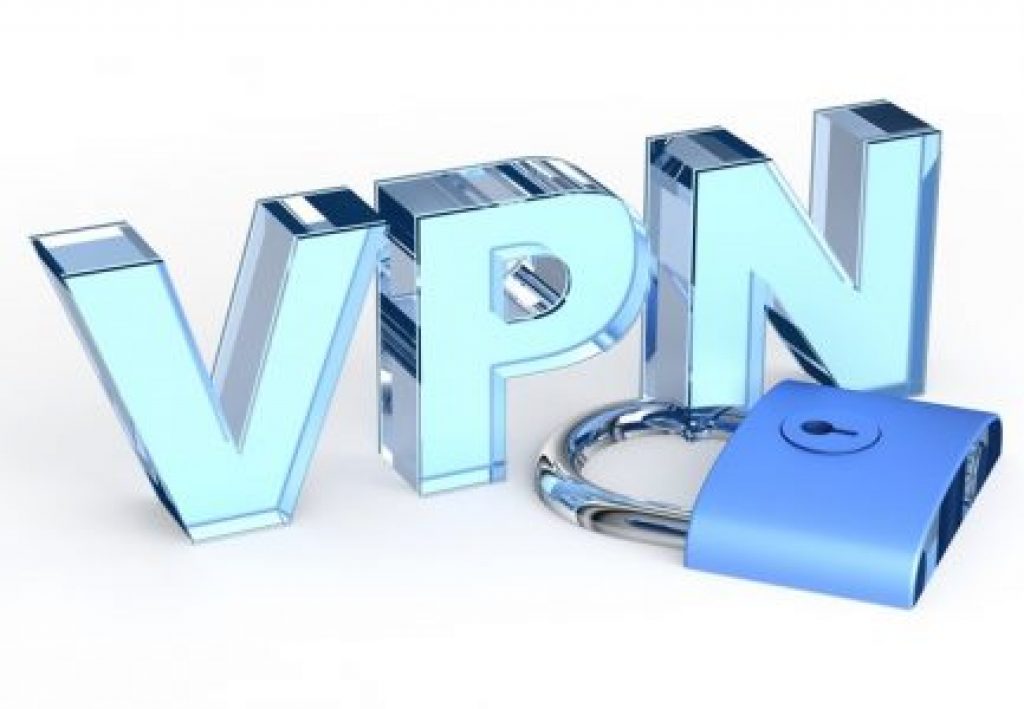
Often, VPNs are implemented at no higher than the average level because the use of privacy techniques at these levels allows the protocols to be used as is.
To create such virtual connection it is necessary to pack data into one element of the PPP protocol into any other, for example, IP, or Ethernet.
VPNs are used not only to create personal networks, but sometimes also to directly access the Internet.
This server can provide the highest level of anonymity and encryption of information with the required level of use of special software, the main thing is to configure all the components correctly.
VPN structure
VPN is made up of two elements:
- external network, through which the data is packaged into a single whole and the connection occurs;
- internal network, which is under external control. It may not be alone, but may have several more similar controlled networks.

The connection occurs via a server associated with both elements of the structure.
During connection, the server requires you to pass an identity verification check, as well as a comparison check of elements already in the database.
Once the verification is completed, the user is given space to use the network.
Servers can be classified according to five main criteria.

According to the degree of security of the environment used:
By purpose:
By implementation method:
| Intranet VPN | Remote Access VPN | Extranet VPN | Internet VPN | Client/Server VPN |
|---|---|---|---|---|
| Combines into one secure network several distributed sections of one complex, which can subsequently exchange data via communication channels that are in the public domain. | Creates a secure channel between parts corporate network and a private user who connects to corporate resources during home use. | Necessary when using those networks to which users from outside can connect, to which they are not particularly high level trust. Access will only be provided to information that does not have strong value and anonymity. | It is necessary for providers to access the network if several users are connected to one channel at the same time. | Provides information security through node-to-node transmission on a corporation's network. This protection is necessary when you need to create several subnets in an entire network, that is, some kind of division of the site into sections. |
By protocol type:
There are several options for implementing servers for TCP/IP, IPX and AppleTalk protocols. But nowadays there is a complete transition to the TCP/IP protocol, which most VPN servers support.
By network protocol level:
The network protocol level is mapped to the exemplary system level of the /OSI model.
What does a VPN do?
→ This server changes the IP address from which the connection occurs to a fictitious one, for example Germany.
When using a VPN, no one will know who exactly you visited a certain site. Administrators will only see that you are from Germany;
→ The connection is encrypted. That is, neither yours System Administrator, nor the provider will be able to find out your network usage history;

→ Without this server, your provider has access to your entire search history, without any exceptions. And through a VPN, no one except you will know anything.
→ Hackers and crackers will not be able to intercept your data, and even if they can, they will never decrypt it;
→ By encrypting your data, your use will be absolutely safe and confidential.
When should you connect to a VPN?

- If you use Wi-Fi when visiting public institutions, then when connected, not a single hacker will be able to intercept data about your bank card, secret codes and passwords to payment systems where your money is stored;
- you don't like the fact that your entire search history is being viewed by a provider who can see what payment system your funds are stored and you want complete anonymity;
- you don’t want your bosses at your job to look at your search history, which shouldn’t be there during working hours;
- you want to visit sites without the restrictions of services blocking them;
- The laws of your country restrict access to your favorite servers or if they indicate certain privileges when moving from a specific country.
In such cases, you definitely need this server.
VPN in Google Chrome

It happens that you want to access a certain site, but it turns out to be blocked by the laws of your country. How does the network figure out that you are from a given country?
The thing is that your location can be calculated by IP address, and because of this you end up on the list of blocked users and cannot access this site.
But these blocks can be bypassed if you mask your address and create a secure connection. This method will increase the degree of confidentiality and to do this, you need a VPN.
Below we provide detailed instructions, which can be used to make this even easier.
1 So, open the browser Google Chrome .
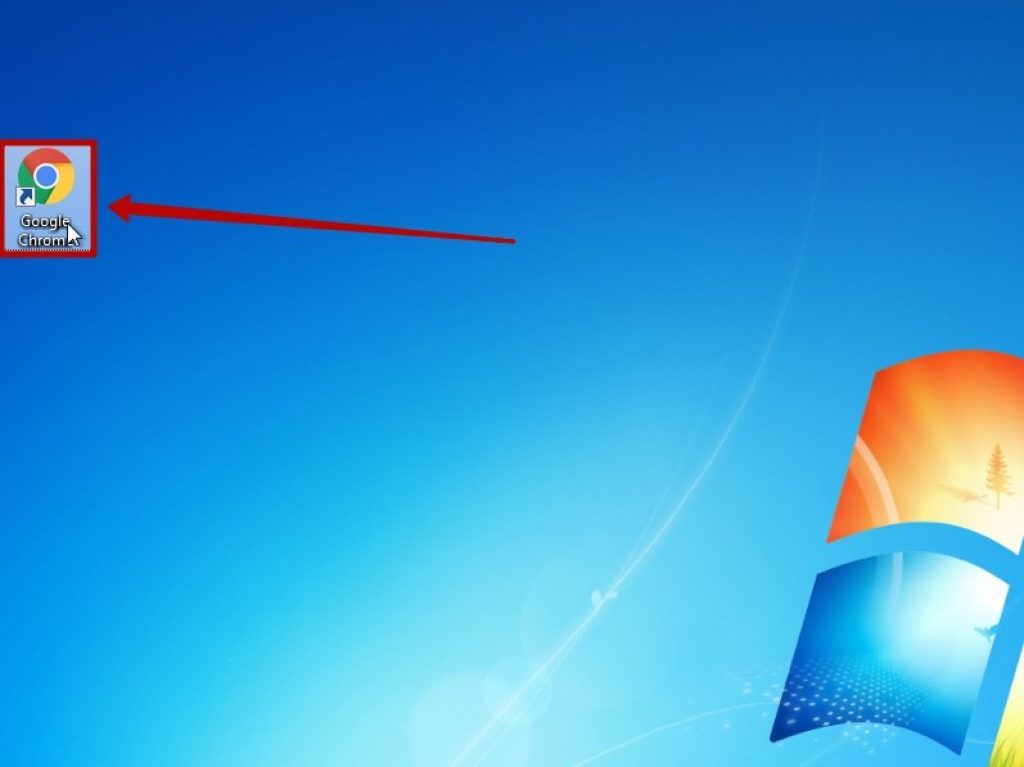
2 To the right of address bar are looking for "Settings" and go into them.

3 A settings menu will open in which we need to find and select the item.
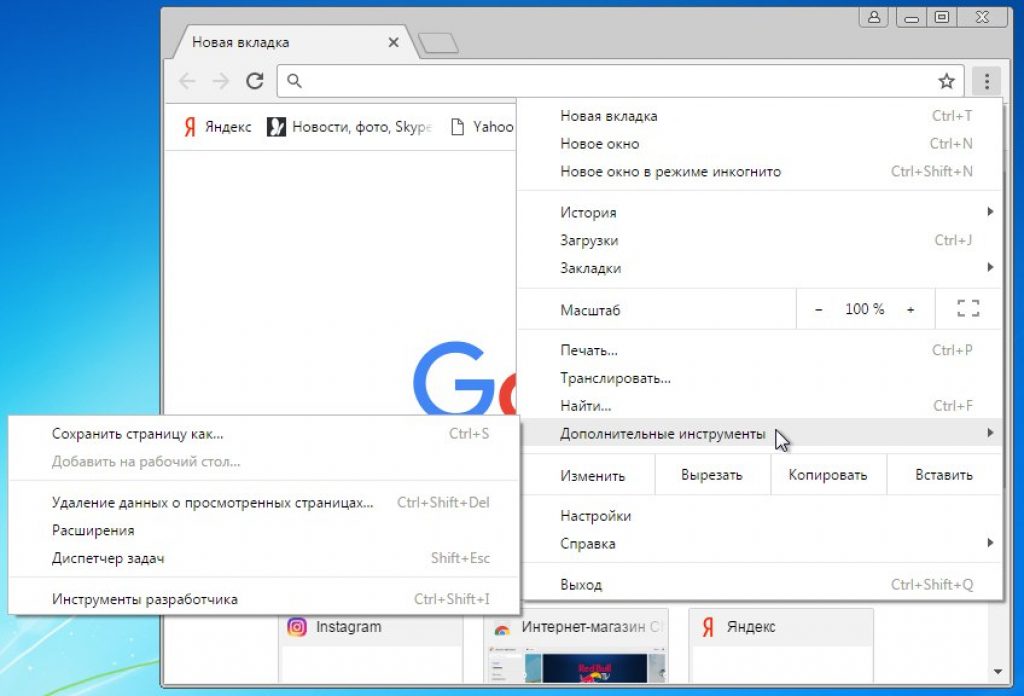
4 Select the tab there .

5 In it you will see a list of all that are already installed. To add a new one, click on the item.

6 Then the repository will open, in the search bar of which you need to enter browsec vpn and begin the search directly.
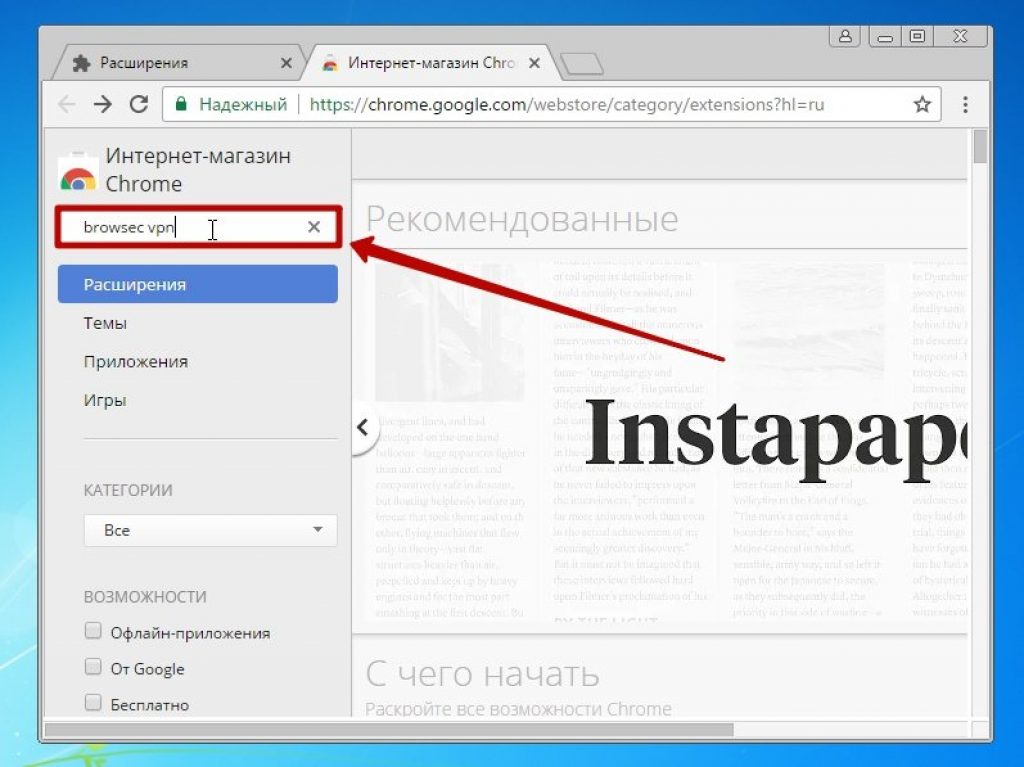
7 From the list of options, select what we need and install it.
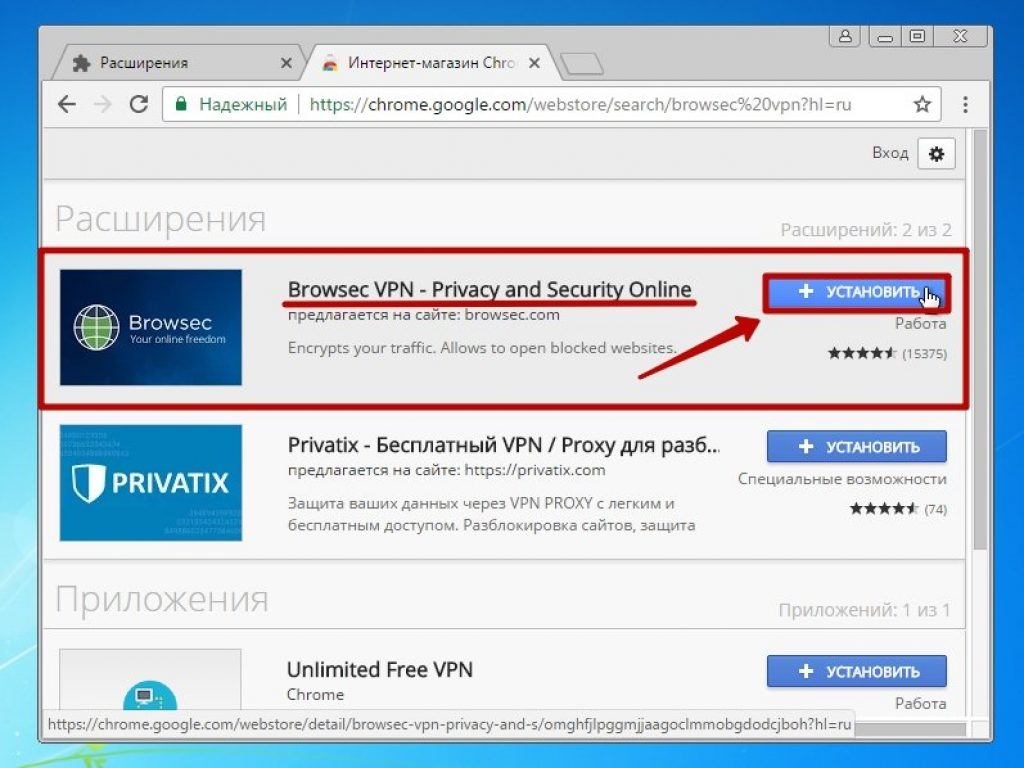
8 To combine it with the browser, you should specify "Install extension" .

9 After installing it to the right of the address bar, near "Settings" , the icon for this extension will be visible, to configure which you need to go into it.

10 To start its activity, it is necessary to switch a certain lever to the on mode.

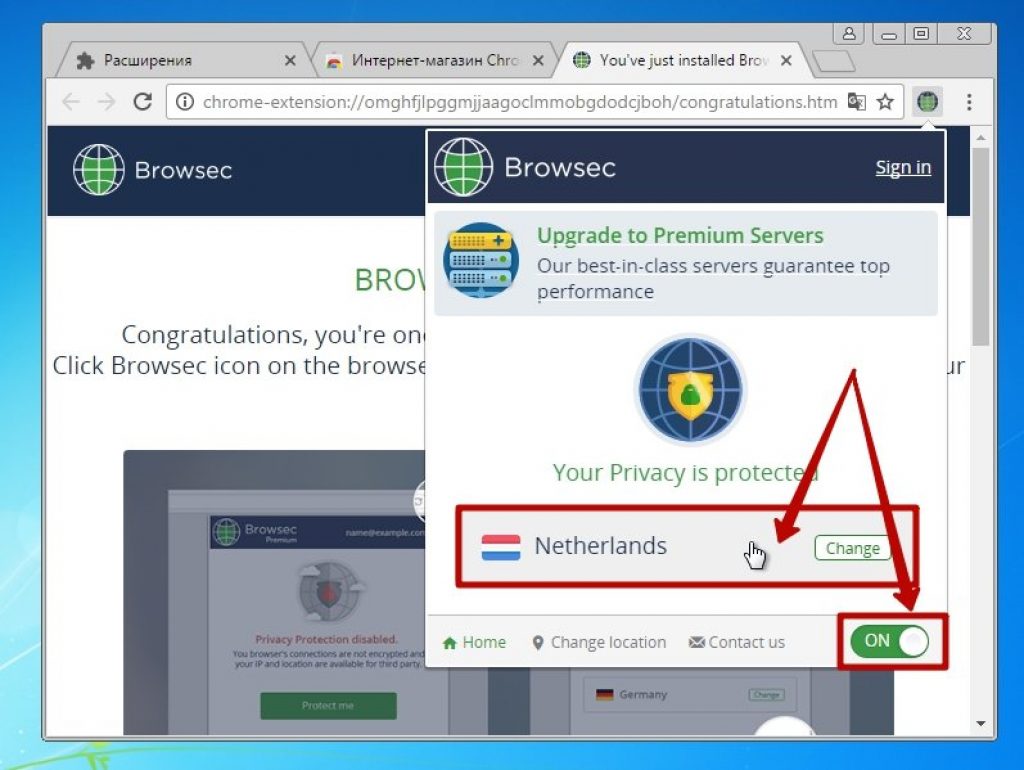
12 To select a country, you need to go to the list of countries and click on its name. Available free options include: Netherlands, UK, USA and Singapore. To select additional countries, you must register paid subscription to the server.
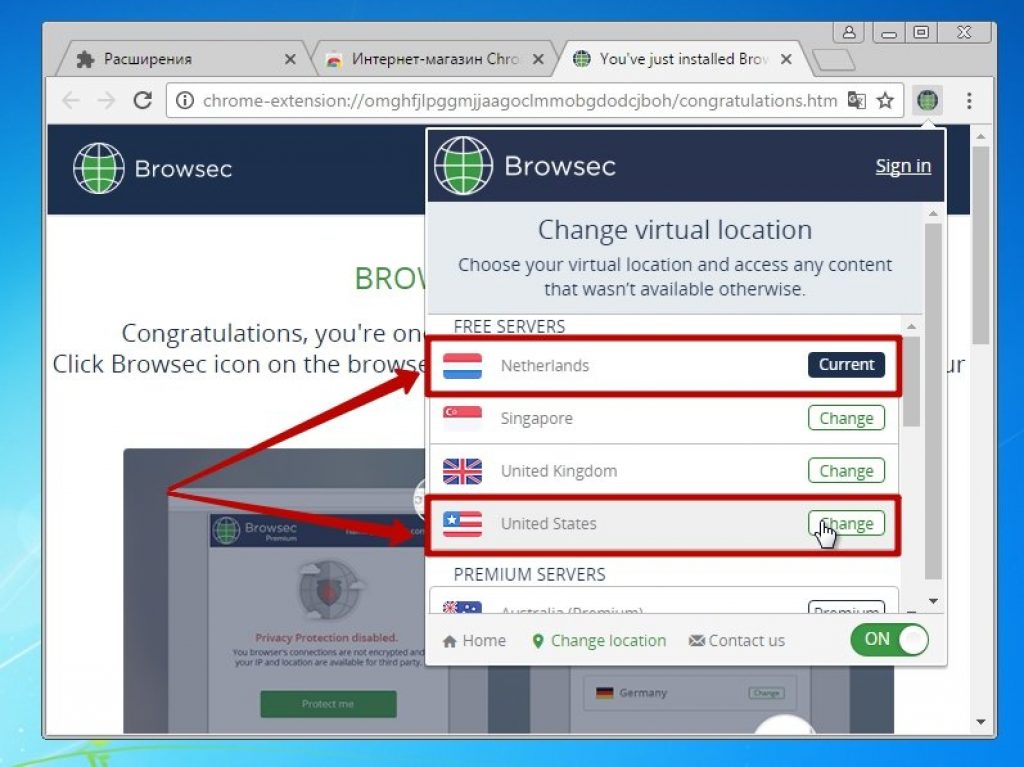
Completing the installation
By installing a VPN in Google Chrome, you will be able to anonymously visit any site on the Internet.
The extension that we reviewed above is absolutely free, but also has a premium subscription for advanced features.
The data speed of the 4 countries to choose from is somewhat limited and in order to have greater capabilities, you must purchase the premium version of the extension.
This extension will help to bypass both at the private level of use and at the territorial and global levels. It is also used for security purposes.
VPN for Yandex browser

Here we will present detailed instructions on how to install the same extension, only in the Yandex browser.
- Find the required browser on your desktop.

- Click on the tab "Settings" .

- We find the item in the list.

- We choose from them .

- In the search we enter Browsec- the addition we need.

- Let's add it.

- And we install.

- Just like Chrome, an extension icon has appeared near the search bar, click on it.

- Switch the slider to enable mode.

- Pressing Change, you will have the opportunity to change the country through which the connection will occur.

- Select from the list the country that you consider preferable for further connection.

- Ready!
Completion
In addition to the Browsec extension, there are many more servers, but this one is considered one of the more secure and reliable.
In addition, we can recommend the Hola extension for Yandex. It is identical in operation to the one we gave as an example during installation and is also absolutely free.
There are countries where you can get jail time for using VPN servers. In countries such as Iraq and Iran, these servers are strictly prohibited.
Installing a VPN on Android

L2TP/IPsec protocol
Using this connection method, you can use the resources of the corporate network in secure access.
Before connecting to the VPN server, you need to ask your network administrator for access information.
- "Settings" smartphone item « Wireless network» , then "VPN Settings" and onwards "Add VPN" .

- When creating, you must specify “Add L2TP/IPSec VPN” , and a window with the settings of the created network will open.
You must enter three values:
- in the first field write any convenient connection name;
- in the second, enter the IP address of the VPN server
- in the third, enter the secret key.

- After this, you will see that the created connection has become available and you need to connect to it.

- During the first launch, you need to specify the username and . And in order not to enter this data at each subsequent connection, you can check the box "Save details" .

- If all the data is correct, your successful current status will be displayed in the connection status.

- Installation completed. In case you are unable to connect, try restarting your device and try again.
PPTP protocol
This is one of the most famous connection methods, through node to node. It is a standard of use, so connecting will not be difficult and will delight you with its speed.
- First you need to find in "Settings" smartphone, as in the previous method, select "More" , then « Virtual network» (VPN).

- And further "Add" .

